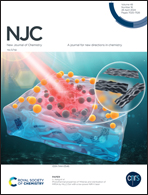Hydrogen-bonded organic frameworks with extended conjugate systems for boosted photocatalytic degradation†
Abstract
Restricted light absorption spectra in conjunction with intrinsic material instability present formidable challenges to the effective functionality of existing photocatalytic systems. As a viable alternative to conventional photocatalytic materials, hydrogen-bonded organic frameworks (HOFs) can form conjugated systems through coupling and stacking effects, which can effectively promote the rapid transfer of charge over a wide optical range and improve the stability and photocatalytic activity. Herein we employ a large conjugate system material based on cobalt phthalocyanine (HOF-CoPcTc) as a proof of concept for this approach. The carboxyl groups in the tetracarboxy cobalt phthalocyanine were conjugated with phthalocyanine macrocycles which could extend the π-electron conjugation system of HOF-CoPcTc. Remarkably, the decomposition rate of the sulfamethoxazole (SMX) molecule in an aqueous solution was about 99% after 120 min under visible light irradiation for HOF-CoPcTc, which is a significant 9.78-fold improvement over that of the ligand CoPcTc. This study demonstrated that metal phthalocyanine compositions with carboxyl groups can be used to successfully synthesize HOF materials for large conjugated systems and provide a useful method for achieving efficient photocatalytic degradation of antibiotics.



 Please wait while we load your content...
Please wait while we load your content...